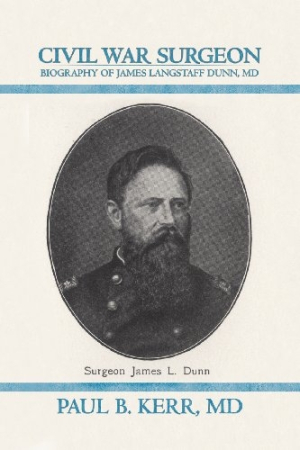Civil War Surgeon
“The nice fancy parades that have so pleased the people of Pitt is now over and the grim visage of war is what we will be introduced to for the next sixty days and perhaps longer.” So wrote Union Army surgeon James L. Dunn to his wife in May of 1861, a few weeks before the Battle of Bull Run. It would be four years and nineteen battles before he came home, and during all of that time Dunn never stopped writing, not even after the war was over.
Civil War Surgeon is a collection of 140 of Dunn’s letters and some of his other writings, all artfully edited by a fellow army doctor and combat veteran, Paul B. Kerr. Kerr shares Dunn’s Pennsylvania roots, and his family has a distant connection to the Civil War doctor. Some of the letters were found by Kerr’s cousin in the attic of a deceased relative; the rest he tracked down through visits to museums, libraries, and the University of Virginia. Kerr’s detective work is to be lauded, along with his painstaking deciphering of the letters, many of them stained, faded, or otherwise worn with age. Through his diligence and attention to detail, Kerr opens a window to the past and gives readers an eyewitness view of a rarely seen side of the national tragedy.
Some of the letters to his wife, Tempy, are sweet, poignant, and full of longing for home. Others are angry missives decrying the stupidity of generals and the outrages committed by the South’s slave-holding “feudal aristocracy,” which he decries for being “at war with democracy.”
Dunn describes in detail the horrors of battlefield surgery. In one particular battle, he is covered with blood from head to toe and lops off limbs for twenty-four hours straight, often with cannonballs quite literally whistling through his surgical tent. Three years into this life of horror, Dunn had the opportunity to come home, his service done, but he could not leave his fellow soldiers. As he explains to his wife, as much as he longs to be in her arms, he re-enlists, as he feels it is his duty to stand by the men for as long as he is needed.
Dunn’s letters account for just over half of the book. The rest is a collection of nearly sixty short essays, some by Dunn, some by others, and some written or annotated by Kerr. While Kerr is, at times, a bit too casual and familiar in these sections (he has an amusing penchant for overuse of exclamation points), his offerings are informative, honest, and entertaining. Kerr’s notes about how his own combat medical experiences compare and contrast with those of the Civil War doctor and helps put the difficulties in perspective for the modern reader.
Reviewed by
Mark McLaughlin
Disclosure: This article is not an endorsement, but a review. The publisher of this book provided free copies of the book and paid a small fee to have their book reviewed by a professional reviewer. Foreword Reviews and Clarion Reviews make no guarantee that the publisher will receive a positive review. Foreword Magazine, Inc. is disclosing this in accordance with the Federal Trade Commission’s 16 CFR, Part 255.

